HOW TO: Install VMware Tools for Linux on a VMware Linux virtual machine on a VMware vSphere Hypervisor 5.1 (ESXi 5.1) Host Server
EE Fellow, MVE, Expert of the Year 2021,2017-11, Scribe 2016-2012, Author of the Year 2018-6,2013-2012 VMware vExpert Pro, vExpert 2022-2011
Published:
Browse All Articles > HOW TO: Install VMware Tools for Linux on a VMware Linux virtual machine on a VMware vSphere Hypervisor 5.1 (ESXi 5.1) Host Server
In my previous 26 VMware Articles, most featured Intermediate VMware Topics. My next series of articles will concentrate on topics for the VMware Novice; this is the nineth article in this series.
If you would like to read the other articles in this series, they are listed here for your convenience.
Part 1: HOW TO: Install and Configure VMware vSphere Hypervisor 5.1 (ESXi 5.1)
Part 2: HOW TO: Connect to the VMware vSphere Hypervisor 5.1 (ESXi 5.1) using the vSphere Client
Part 3: HOW TO: Create an ISO CD-ROM/DVD-ROM image (*.iso), and MD5 checksum signature, for use with VMware vSphere Hypervisor 5.1 (ESXi 5.1)
Part 4: HOW TO: Upload an ISO CD-ROM/DVD-ROM image to a VMware datastore for use with VMware vSphere Hypervisor 5.1 (ESXi 5.1) using the vSphere Client, and checking its MD5 checksum signature is correct.
Part 5: HOW TO: Enable SSH Remote Access on a VMware vSphere Hypervisor 5.1 (ESXi 5.1)
Part 6: HOW TO: Create your first Linux Virtual Machine on a VMware vSphere Hypervisor 5.1 (ESXi 5.1) Host Server
Part 7: HOW TO: Create your first Windows Virtual Machine on a VMware vSphere Hypervisor 5.1 (ESXi 5.1) Host Server
Part 8: HOW TO: Install VMware Tools for Windows on a VMware Windows virtual machine on a VMware vSphere Hypervisor 5.1 (ESXi 5.1) Host Server
In this series of basic VMware articles for the Novice, I'll be showing you the basic VMware skills required to install, configure and deploy virtual machines using VMware's FREE VMware vSphere Hypervisor (ESXi).
In this article we will show you HOW TO: Install VMware Tools for Linux on a VMware Linux virtual machine on a VMware vSphere Hypervisor 5.1 (ESXi 5.1) Host Server. This procedure can be followed to install VMware Tools on any Linux Virtual Machine provided they are supported by the version of VMware vSphere. You may want to consult the the VMware Hardware Compatibility Lists or HCL, see here to check your operating system is compatible with VMware vSphere.
What are VMware Tools?
VMware Tools are a suite of utilities that enhances the performance of the virtual machine's guest operating system and improves management of the virtual machine. Installing the VMware Tools package will greatly enhance graphics and mouse performance in your virtual machine. Without VMware Tools installed in your guest operating system, guest performance lacks important functionality. You can check if you have VMware Tools installed by checking the Summary of your virtual machine using the vSphere Client if using VMware vSphere 4.x or 5.x, or ESX/ESXi 4.x, 5.x. If VMware Tools are installed VMware Tools will read OK, an IP Address and DNS hostname will appear in the Summary page.
![VMware Tools status in Summary]()
![Inventory]() Click the Inventory icon.
Click the Inventory icon.
![Click Host in Inventory]() followed by the Virtual Machines configuration tab.
followed by the Virtual Machines configuration tab.
![Virtual Machine Tab]() Right Click the location marked with the red arrow, the name field. This allows us to add other useful columns, which will show the status of VMware Tools, and whether VMware Tools is installed in the virtual machine. This feature shows us the information for all virtual machines running on this host.
Right Click the location marked with the red arrow, the name field. This allows us to add other useful columns, which will show the status of VMware Tools, and whether VMware Tools is installed in the virtual machine. This feature shows us the information for all virtual machines running on this host.
![select required fields]() Place a tick box and select IP Address, VMware Tools Running State and VMware Tools Version Status, this will enable additional columns.
Place a tick box and select IP Address, VMware Tools Running State and VMware Tools Version Status, this will enable additional columns.
![Additional Columns Enabled]()
If VMware Tools is installed and running, VMware Tools Running Status states Running, and an IP Address is displayed. Also the VMware Tools Version Status states - Current. If VMware Tools is not installed, please continue with the following steps.
As you can see from the above information VMware Tools has been installed on our Windows virtual machine, "My First Windows VM", but VMware Tools has not been installed on "My First Linux VM" yet. Please see my previous EE Article Part 8: HOW TO: Install VMware Tools for Windows on a VMware Windows virtual machine on a VMware vSphere Hypervisor 5.1 (ESXi 5.1) Host Server to install VMware Tools on a Windows virtual machine. To install VMware Tools on Linux, please continue with this tutorial.
![Open Console]() and then selecting the Power On button on the ribbon bar
and then selecting the Power On button on the ribbon bar
![Power On Virtual Machine Button]() the virtual machine should automatically boot the operating system. The Open Console function is similar to the Keyboard/Video Machine (KVM) function in a datacentre, which allows you to toggle between console screens of computers, it allows you to interact with the virtual machine, with keyboard and mouse movements, and displays the screen. The Linux console screen will be displayed.
the virtual machine should automatically boot the operating system. The Open Console function is similar to the Keyboard/Video Machine (KVM) function in a datacentre, which allows you to toggle between console screens of computers, it allows you to interact with the virtual machine, with keyboard and mouse movements, and displays the screen. The Linux console screen will be displayed.
![Linux Console Screen]()
Password Entered
![Linux Console Screen Password Entered]() After a successful login, the Linux desktop will appear.
After a successful login, the Linux desktop will appear.
![Linux Console Screen Desktop]()
Select VM > Guest > Install/Upgrade VMware Tools
![Select VM > Guest > Install/Upgrade VMware Tools]() This process connects a VMware Tools for Linux (linux.iso) iso file image to the CD-ROM device in the virtual machine. If VMware Tools fails to run, ensure that your virtual machine has a CD-ROM device added. At the Install VMware Tools dialogue box, click OK
This process connects a VMware Tools for Linux (linux.iso) iso file image to the CD-ROM device in the virtual machine. If VMware Tools fails to run, ensure that your virtual machine has a CD-ROM device added. At the Install VMware Tools dialogue box, click OK
![Install VMware Tools Prompt]() Select the terminal application in Linux.
Select the terminal application in Linux.
![Linux terminal]() Ensure you virtual machine is connected to the internet. We will need to connect to the internet to update the virtual machine and download application packages. I've found if you update you Linux distribution after installing VMware Tools, you can break the VMware Tools installation.
Ensure you virtual machine is connected to the internet. We will need to connect to the internet to update the virtual machine and download application packages. I've found if you update you Linux distribution after installing VMware Tools, you can break the VMware Tools installation.
Type the following command in the console
sudo apt-get update
the above commend will contact the distribution servers, for Ubuntu Linux updates.![sudo apt-get update]() Type the following command in the console to upgrade the Ubuntu Linux virtual machine with updates available.
Type the following command in the console to upgrade the Ubuntu Linux virtual machine with updates available.
sudo apt-get upgrade
![sudo apt-get upgrade]() Select Y to upgrade the patches.
Select Y to upgrade the patches.
![sudo apt-get upgrade complete]() When the upgrades have been completed type
When the upgrades have been completed type
sudo mkdir /tmp/tools
sudo mkdir /mnt/cdrom
at the console, these are folders we will use in this tutorial for the installation of VMware Tools.
![sudo mkdir]() type sudo mount /dev/cdrom /mnt/cdrom to mount the CD-ROM with VMware Tools.
type sudo mount /dev/cdrom /mnt/cdrom to mount the CD-ROM with VMware Tools.
![sudo mount]() list the contents of the CD-ROM with ls -al /mnt/cdrom, the file VMwareTools-9.0.0-782409.t
list the contents of the CD-ROM with ls -al /mnt/cdrom, the file VMwareTools-9.0.0-782409.tar.gz contains the VMware Tools installer.
![VMware Tools cdrom contents]() Copy the file from the CD-ROM, to the /tmp/tools folder, type the command
Copy the file from the CD-ROM, to the /tmp/tools folder, type the command
cd /mnt/cdrom
sudo cp VMwareTools-9.0.0-782409.tar.gz /tmp/tools
Check the VMware Tools gziped tar ball file has been copied into /tmp/tools, type ls -al /tmp/tools
![check tools]() Extract the VMware Tools gziped tar ball file, by typing the following sudo tar zxvf VMwareTools-9.0.0-782409.t
Extract the VMware Tools gziped tar ball file, by typing the following sudo tar zxvf VMwareTools-9.0.0-782409.tar.gz , and wait, this can take a few minutes to extract. (enter you password when prompted!), as the files are extracted the files will scroll up the screen.
![VMware Tools extraction]() Check the current folder for the new folder called vmware-tools-distrib using the command ls -al. Change directory using the cd command, and type cd vmware-tools-distrib.
Check the current folder for the new folder called vmware-tools-distrib using the command ls -al. Change directory using the cd command, and type cd vmware-tools-distrib.
![check folder]() gcc, make and the kernel headers of the running kernel are later required by the VMware Tools installation to compile the drivers for you Linux distribution, so install first, otherwise tools installation will fail. To check and install you have the binaries gcc and make type
gcc, make and the kernel headers of the running kernel are later required by the VMware Tools installation to compile the drivers for you Linux distribution, so install first, otherwise tools installation will fail. To check and install you have the binaries gcc and make type
sudo apt-get install gcc
sudo apt-get install make
sudo apt-get install linux-headers-generic
at the terminal window. Execute the VMware Tools installation script, by typing the command sudo ./vmware-install.pl
At the Creating a new VMware Tools installer database Installing VMware Tools prompt, just hit the enter key to accept the defaults to the following paths
/usr/bin
/etc
/etc/init.d
/usr/sbin/
/usr/lib/vmware-tools
![VMware Tools Install1]() Answer yes to creating the folder /usr/lib/vmware-tools, this can take a few minutes to complete.
Answer yes to creating the folder /usr/lib/vmware-tools, this can take a few minutes to complete.
![Answer Yes]() At the which directory do you want to install the documentation files, hit enter.
At the which directory do you want to install the documentation files, hit enter.
![Hit enter at the documentation prompt]() Hit enter at the /usr/share/doc/vmware-tool
Hit enter at the /usr/share/doc/vmware-tools prompt, to create the folder.
![Hit enter at the /usr/share/doc/vmware-tools prompt, to create the folder.]() The VMware Tools installer, will report if the installation has been sccessful.
The VMware Tools installer, will report if the installation has been sccessful.
This will complete the installation of VMware Tools 9.0.0 build-782409 for Linux.
![VMware Tools Install successfull]() Before running VMware Tools for the first time, it needs to be configured. At the prompt to run the configuration program /usr/bin/vmware-config-too
Before running VMware Tools for the first time, it needs to be configured. At the prompt to run the configuration program /usr/bin/vmware-config-tools.pl hit enter, to run the configuration program.
![VMware Tools Install successfull]() The following screen will be displayed as VMware Tools initializes
The following screen will be displayed as VMware Tools initializes
![VMware Tools Initalizing]() If you require the VMware FileSystem Sync Driver select - yes, this will ensure third party backup products, obtain a consistent backup.
If you require the VMware FileSystem Sync Driver select - yes, this will ensure third party backup products, obtain a consistent backup.
![VMware Tools Sync Driver]() Hit enter to accept the default path for gcc.
Hit enter to accept the default path for gcc.
![VMware Tools Compile options]() Hit enter to accept the default path for kernel headers.
Hit enter to accept the default path for kernel headers.
![VMware Tools Compile kernel headers]() (if your kernel headers are missing, you will need to issue a sudo apt-get install linux-headers-generic command).
(if your kernel headers are missing, you will need to issue a sudo apt-get install linux-headers-generic command).
Hit enter to accept the default folder. The drivers will be compiled
![VMware Tools Compile drivers]()
![VMware Tools Compile drivers continued]()
![VMware Tools Compile drivers continued]()
![VMware Tools Compile drivers continued]()
![VMware Tools Compile drivers finished]() If you are using VMware Workstation or VMware Player, you may want to enable and install the VMware Host Guest Filesystem driver, which allows the exchange of files between host and virtual machine. This feature is not supported in VMware vSphere. In this tutorial, the Host is VMware vSphere, so we will not be installing the VMware Host Guest Filesystem driver, so select the default action - no.
If you are using VMware Workstation or VMware Player, you may want to enable and install the VMware Host Guest Filesystem driver, which allows the exchange of files between host and virtual machine. This feature is not supported in VMware vSphere. In this tutorial, the Host is VMware vSphere, so we will not be installing the VMware Host Guest Filesystem driver, so select the default action - no.
![VMware Tools Compile no drivers]() vmblock is a feature which allows cut and paste between Host computer and VMware Workstation or VMware Player virtual machine. This feature is not supported in VMware vSphere. In this tutorial, the Host is VMware vSphere, so we will not be installing the vmblock driver, so select the default action - no.
vmblock is a feature which allows cut and paste between Host computer and VMware Workstation or VMware Player virtual machine. This feature is not supported in VMware vSphere. In this tutorial, the Host is VMware vSphere, so we will not be installing the vmblock driver, so select the default action - no.
![VMware Tools Compile no vmblock]() As this is a production machine, we will not be installing any experimental VMware, automatic building kernels at machine boot. Accept the default no, but hitting Enter.
As this is a production machine, we will not be installing any experimental VMware, automatic building kernels at machine boot. Accept the default no, but hitting Enter.
![VMware Tools Compile no experimental kernel drivers]() The configuration of VMware Tools 9.0.0 build-782409 for Linux has been completed successfully, when the following screen is displayed.
The configuration of VMware Tools 9.0.0 build-782409 for Linux has been completed successfully, when the following screen is displayed.
![VMware Tools Completed]() You must restart your X session before any mouse or graphics changes take effect.
You must restart your X session before any mouse or graphics changes take effect.
You can now run VMware Tools command box, by invoking sudo "/usr/bin/vmware-toolbox-cmd" from the command line.
Unlike in a Microsoft Windows operating system, and computer restart is not required to initialize VMware Tools.
If you now repeat Step 2 above Checking if VMware Tools is installed in the Virtual Machine
![VMware Tools Installed and Current]()
![VMware Tools Installed and Current]() An IP address is now displayed, which is the IP address of the virtual machine, VMware Tools Running Status - Running, and VMware Tools Version Status - Current
An IP address is now displayed, which is the IP address of the virtual machine, VMware Tools Running Status - Running, and VMware Tools Version Status - Current
Congratulations, you have successfully Installed VMware Tools for Linux on a VMware Linux virtual machine on a VMware vSphere Hypervisor 5.1 (ESXi 5.1) Host Server
****************************************************************************
Thank you for reading my article, please leave valuable feedback. If you liked my VMware article and would like to see more Articles from me, please click the Yes button near the: Was this article helpful? at the bottom of this article just below and to the right of this information. Thank You. Do not forget if you have a question about this article or another VMware, Virtualisation, Windows Server 2012 question, why not post a Question for me and the other Experts Exchange Experts in the VMware, Virtualisation, Windows 2008, Windows 2012 Zones. I look forward to hearing from you. - Andy :- twitter @einsteinagogo
****************************************************************************
If you would like to read the other articles in this series, they are listed here for your convenience.
Part 1: HOW TO: Install and Configure VMware vSphere Hypervisor 5.1 (ESXi 5.1)
Part 2: HOW TO: Connect to the VMware vSphere Hypervisor 5.1 (ESXi 5.1) using the vSphere Client
Part 3: HOW TO: Create an ISO CD-ROM/DVD-ROM image (*.iso), and MD5 checksum signature, for use with VMware vSphere Hypervisor 5.1 (ESXi 5.1)
Part 4: HOW TO: Upload an ISO CD-ROM/DVD-ROM image to a VMware datastore for use with VMware vSphere Hypervisor 5.1 (ESXi 5.1) using the vSphere Client, and checking its MD5 checksum signature is correct.
Part 5: HOW TO: Enable SSH Remote Access on a VMware vSphere Hypervisor 5.1 (ESXi 5.1)
Part 6: HOW TO: Create your first Linux Virtual Machine on a VMware vSphere Hypervisor 5.1 (ESXi 5.1) Host Server
Part 7: HOW TO: Create your first Windows Virtual Machine on a VMware vSphere Hypervisor 5.1 (ESXi 5.1) Host Server
Part 8: HOW TO: Install VMware Tools for Windows on a VMware Windows virtual machine on a VMware vSphere Hypervisor 5.1 (ESXi 5.1) Host Server
In this series of basic VMware articles for the Novice, I'll be showing you the basic VMware skills required to install, configure and deploy virtual machines using VMware's FREE VMware vSphere Hypervisor (ESXi).
In this article we will show you HOW TO: Install VMware Tools for Linux on a VMware Linux virtual machine on a VMware vSphere Hypervisor 5.1 (ESXi 5.1) Host Server. This procedure can be followed to install VMware Tools on any Linux Virtual Machine provided they are supported by the version of VMware vSphere. You may want to consult the the VMware Hardware Compatibility Lists or HCL, see here to check your operating system is compatible with VMware vSphere.
What are VMware Tools?
VMware Tools are a suite of utilities that enhances the performance of the virtual machine's guest operating system and improves management of the virtual machine. Installing the VMware Tools package will greatly enhance graphics and mouse performance in your virtual machine. Without VMware Tools installed in your guest operating system, guest performance lacks important functionality. You can check if you have VMware Tools installed by checking the Summary of your virtual machine using the vSphere Client if using VMware vSphere 4.x or 5.x, or ESX/ESXi 4.x, 5.x. If VMware Tools are installed VMware Tools will read OK, an IP Address and DNS hostname will appear in the Summary page.
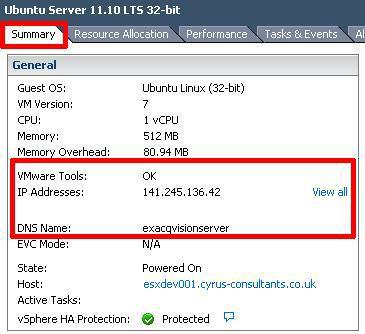
1. Connect to the VMware vSphere Hypervisor 5.1 (ESXi 5.1) or vSphere vCenter Server using the vSphere Client
Please refer to my EE article on HOW TO: Connect to the VMware vSphere Hypervisor 5.1 (ESXi 5.1) using the vSphere Client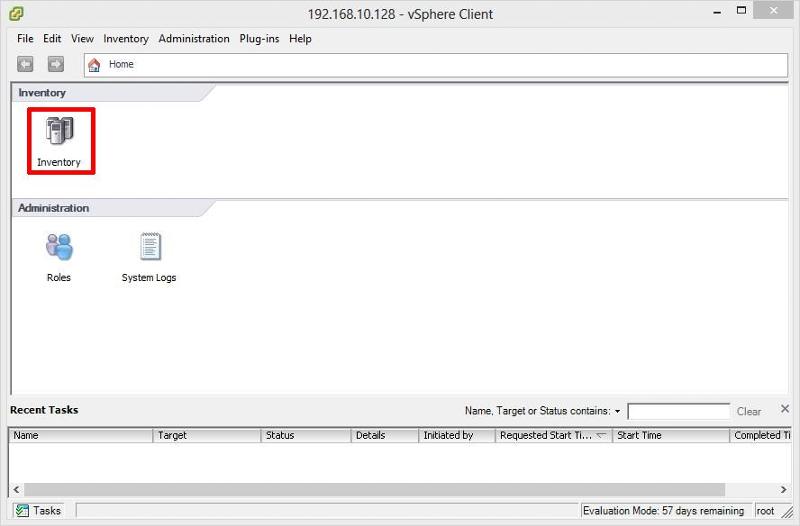 Click the Inventory icon.
Click the Inventory icon.
2. Checking if VMware Tools is installed in the Virtual Machine
Click the Host Server in the Inventory, this is the small server box, with the IP Address [192.168.10.128] in this tutorial.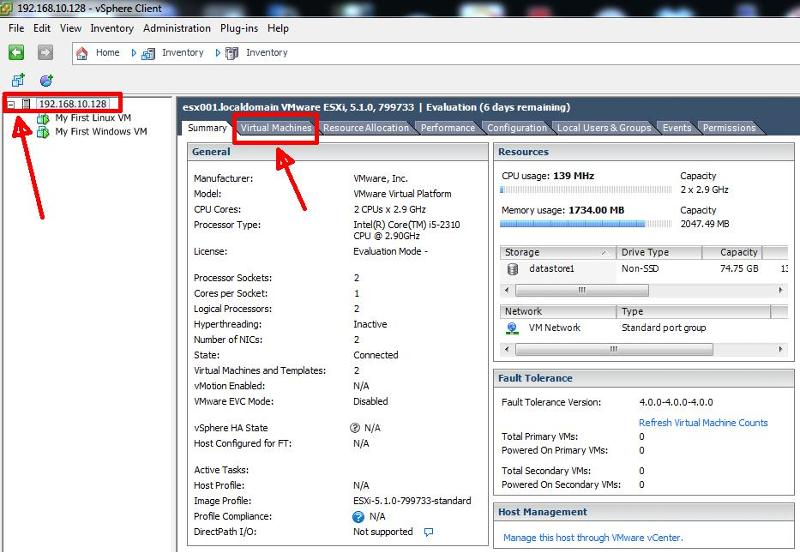 followed by the Virtual Machines configuration tab.
followed by the Virtual Machines configuration tab.
 Right Click the location marked with the red arrow, the name field. This allows us to add other useful columns, which will show the status of VMware Tools, and whether VMware Tools is installed in the virtual machine. This feature shows us the information for all virtual machines running on this host.
Right Click the location marked with the red arrow, the name field. This allows us to add other useful columns, which will show the status of VMware Tools, and whether VMware Tools is installed in the virtual machine. This feature shows us the information for all virtual machines running on this host.
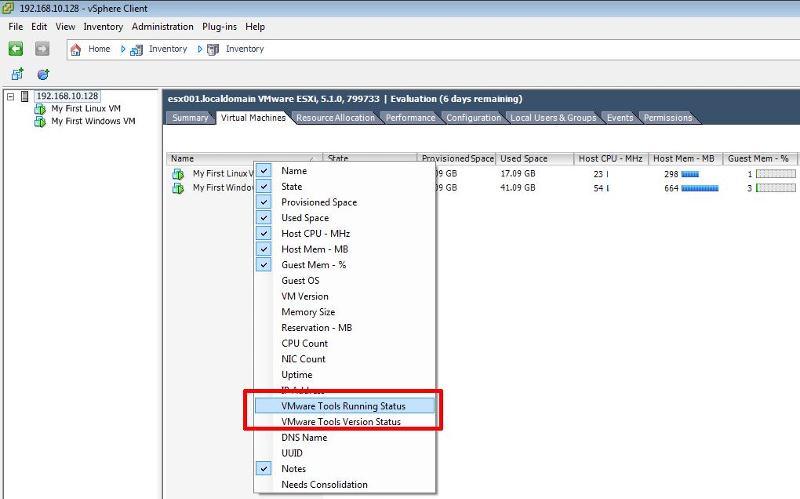 Place a tick box and select IP Address, VMware Tools Running State and VMware Tools Version Status, this will enable additional columns.
Place a tick box and select IP Address, VMware Tools Running State and VMware Tools Version Status, this will enable additional columns.

If VMware Tools is installed and running, VMware Tools Running Status states Running, and an IP Address is displayed. Also the VMware Tools Version Status states - Current. If VMware Tools is not installed, please continue with the following steps.
As you can see from the above information VMware Tools has been installed on our Windows virtual machine, "My First Windows VM", but VMware Tools has not been installed on "My First Linux VM" yet. Please see my previous EE Article Part 8: HOW TO: Install VMware Tools for Windows on a VMware Windows virtual machine on a VMware vSphere Hypervisor 5.1 (ESXi 5.1) Host Server to install VMware Tools on a Windows virtual machine. To install VMware Tools on Linux, please continue with this tutorial.
3. Interacting with the Virtual Machine
Right-Click the virtual machine "My First Linux VM" and Select Power On, or select the virtual machine "My First Linux VM", and type CTRL-B to power on the virtual machine, the virtual machine should automatically boot the operating system. Then select the Open Console function so you can interact with the virtual machine. You may find it easier if you Right-Click the virtual machine "My First Linux VM" and Select Open Console.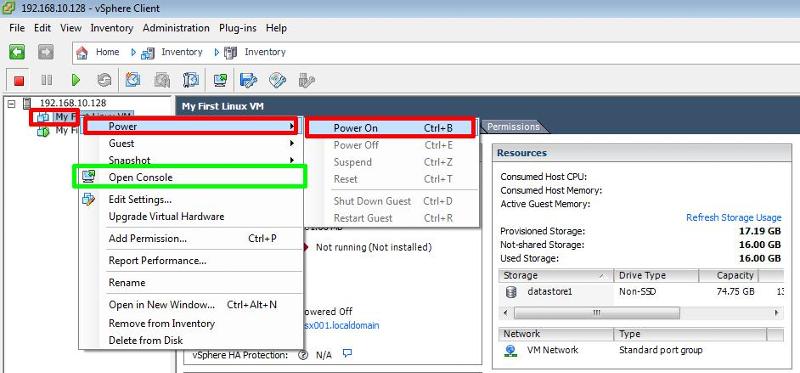 and then selecting the Power On button on the ribbon bar
and then selecting the Power On button on the ribbon bar
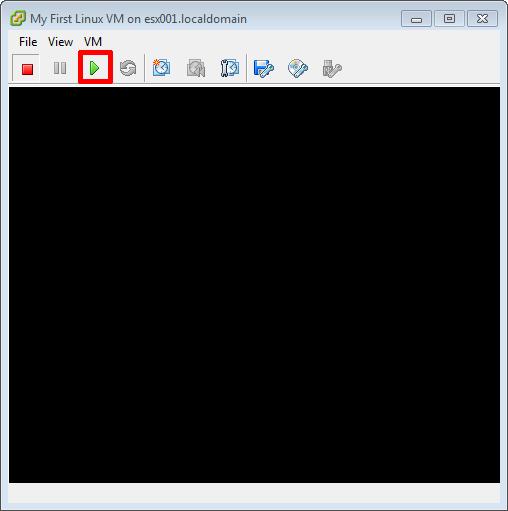 the virtual machine should automatically boot the operating system. The Open Console function is similar to the Keyboard/Video Machine (KVM) function in a datacentre, which allows you to toggle between console screens of computers, it allows you to interact with the virtual machine, with keyboard and mouse movements, and displays the screen. The Linux console screen will be displayed.
the virtual machine should automatically boot the operating system. The Open Console function is similar to the Keyboard/Video Machine (KVM) function in a datacentre, which allows you to toggle between console screens of computers, it allows you to interact with the virtual machine, with keyboard and mouse movements, and displays the screen. The Linux console screen will be displayed.

4. Login to the virtual machine
Select your username and enter your password to access the virtual machine. You may need to change focus, by clicking the virtual machine desktop with the mouse.Password Entered
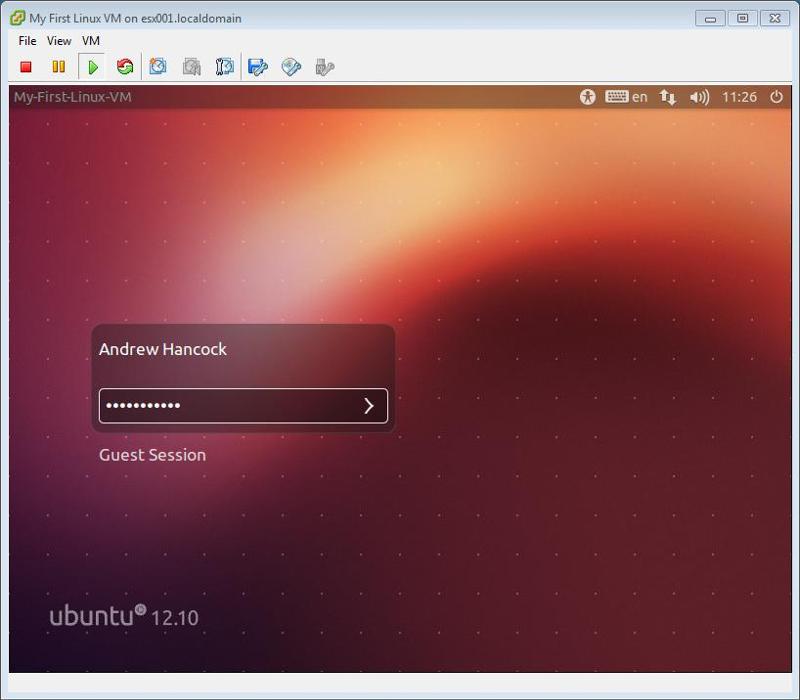 After a successful login, the Linux desktop will appear.
After a successful login, the Linux desktop will appear.

5. Installing VMware Tools for Linux
There are many different methods to installing VMware Tools on Linux, so this could be considered as the "Andy Method of installing VMware Tools on a Linux VMware Virtual Machine". In one of my early Experts Exchange articles, I created a tutorial video of the same procedure here - HOW TO: Tutorial Video - Install VMware Tools for Linux on a VMware Linux virtual machine, I will be following the same method in this article.Select VM > Guest > Install/Upgrade VMware Tools
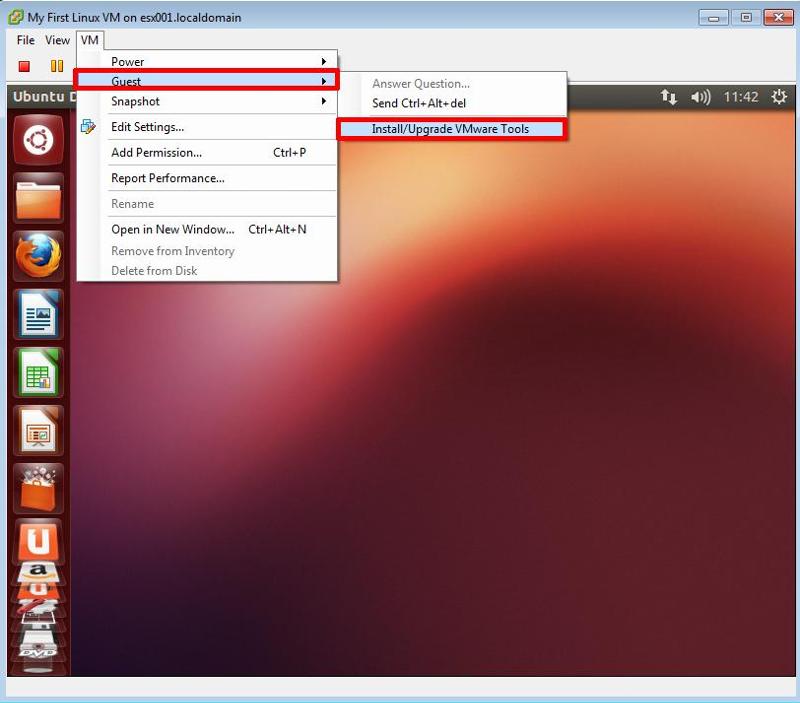 This process connects a VMware Tools for Linux (linux.iso) iso file image to the CD-ROM device in the virtual machine. If VMware Tools fails to run, ensure that your virtual machine has a CD-ROM device added. At the Install VMware Tools dialogue box, click OK
This process connects a VMware Tools for Linux (linux.iso) iso file image to the CD-ROM device in the virtual machine. If VMware Tools fails to run, ensure that your virtual machine has a CD-ROM device added. At the Install VMware Tools dialogue box, click OK
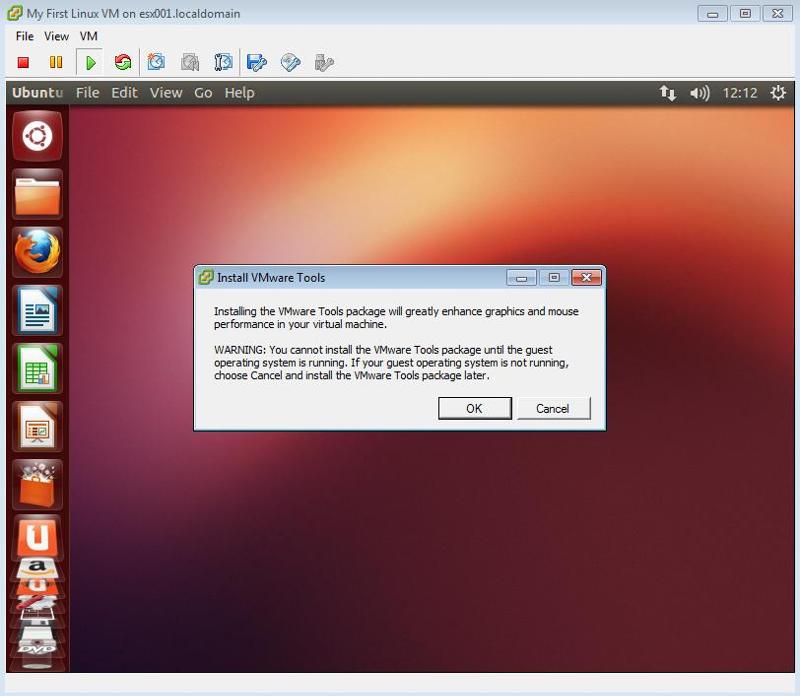 Select the terminal application in Linux.
Select the terminal application in Linux.
 Ensure you virtual machine is connected to the internet. We will need to connect to the internet to update the virtual machine and download application packages. I've found if you update you Linux distribution after installing VMware Tools, you can break the VMware Tools installation.
Ensure you virtual machine is connected to the internet. We will need to connect to the internet to update the virtual machine and download application packages. I've found if you update you Linux distribution after installing VMware Tools, you can break the VMware Tools installation.
Type the following command in the console
sudo apt-get update
the above commend will contact the distribution servers, for Ubuntu Linux updates.
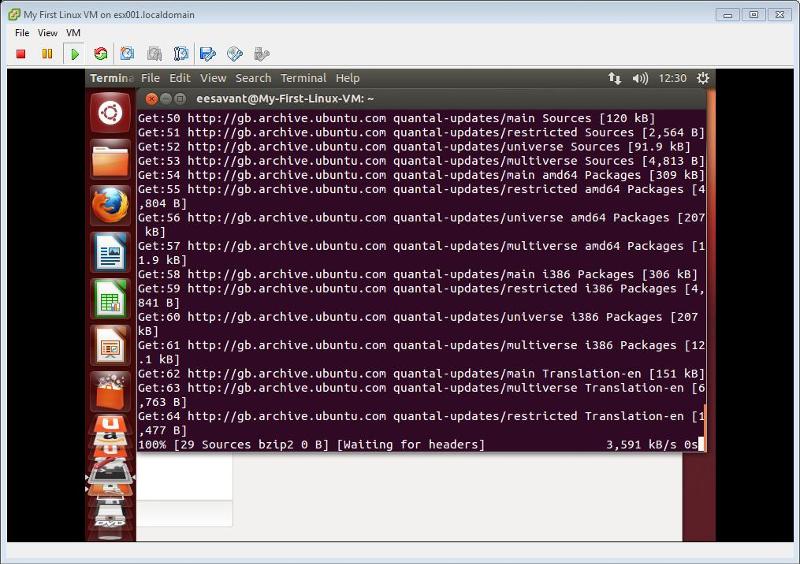 Type the following command in the console to upgrade the Ubuntu Linux virtual machine with updates available.
Type the following command in the console to upgrade the Ubuntu Linux virtual machine with updates available.
sudo apt-get upgrade
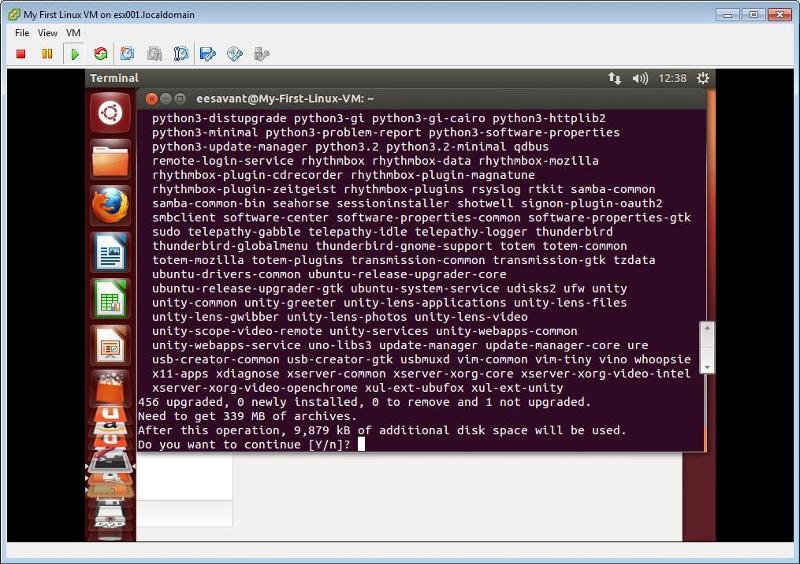 Select Y to upgrade the patches.
Select Y to upgrade the patches.
 When the upgrades have been completed type
When the upgrades have been completed type
sudo mkdir /tmp/tools
sudo mkdir /mnt/cdrom
at the console, these are folders we will use in this tutorial for the installation of VMware Tools.
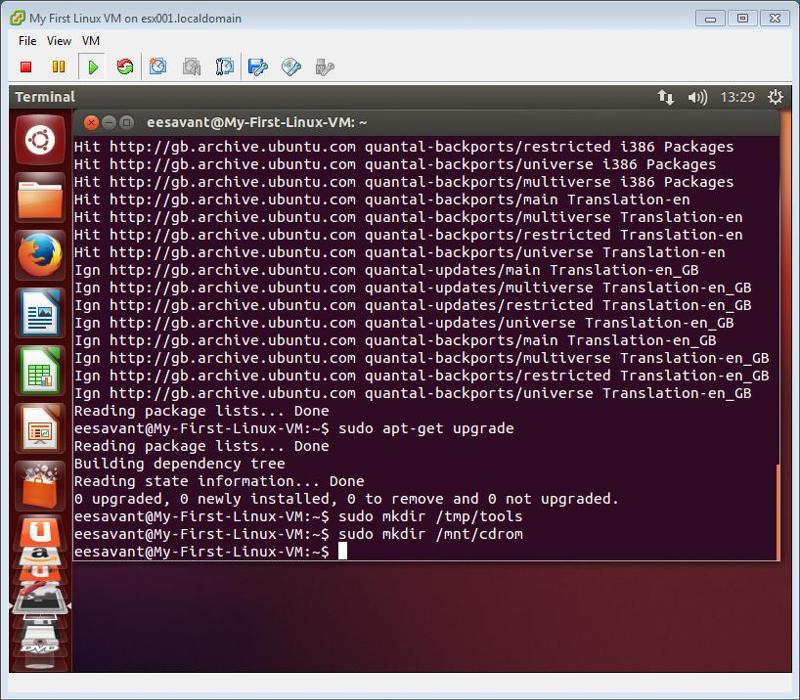 type sudo mount /dev/cdrom /mnt/cdrom to mount the CD-ROM with VMware Tools.
type sudo mount /dev/cdrom /mnt/cdrom to mount the CD-ROM with VMware Tools.
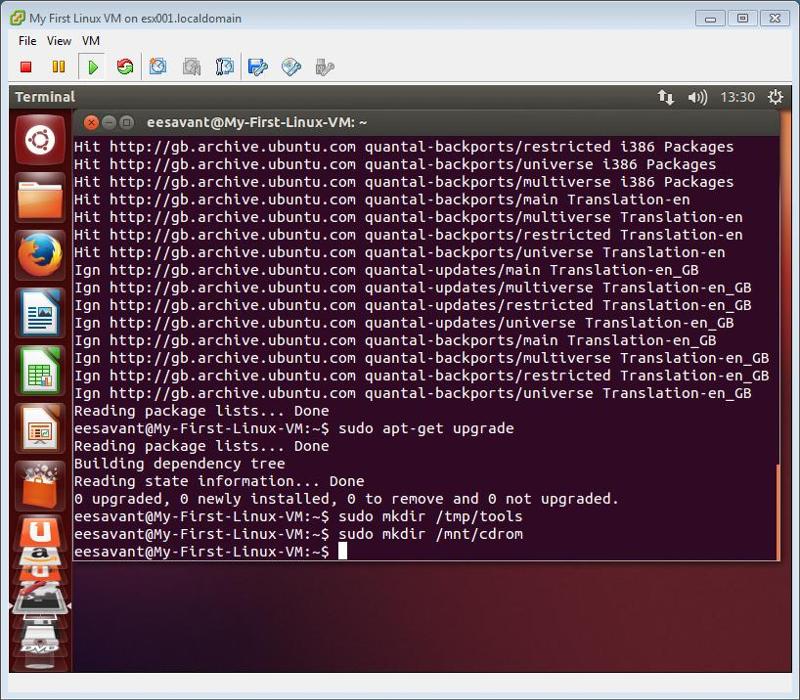 list the contents of the CD-ROM with ls -al /mnt/cdrom, the file VMwareTools-9.0.0-782409.t
list the contents of the CD-ROM with ls -al /mnt/cdrom, the file VMwareTools-9.0.0-782409.t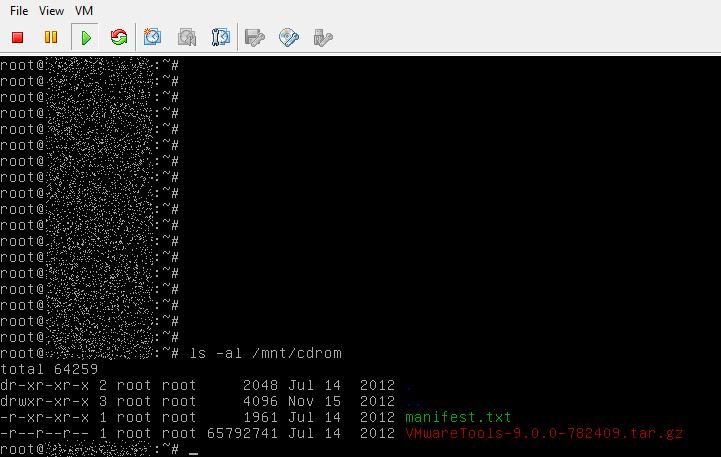 Copy the file from the CD-ROM, to the /tmp/tools folder, type the command
Copy the file from the CD-ROM, to the /tmp/tools folder, type the command
cd /mnt/cdrom
sudo cp VMwareTools-9.0.0-782409.t
Check the VMware Tools gziped tar ball file has been copied into /tmp/tools, type ls -al /tmp/tools
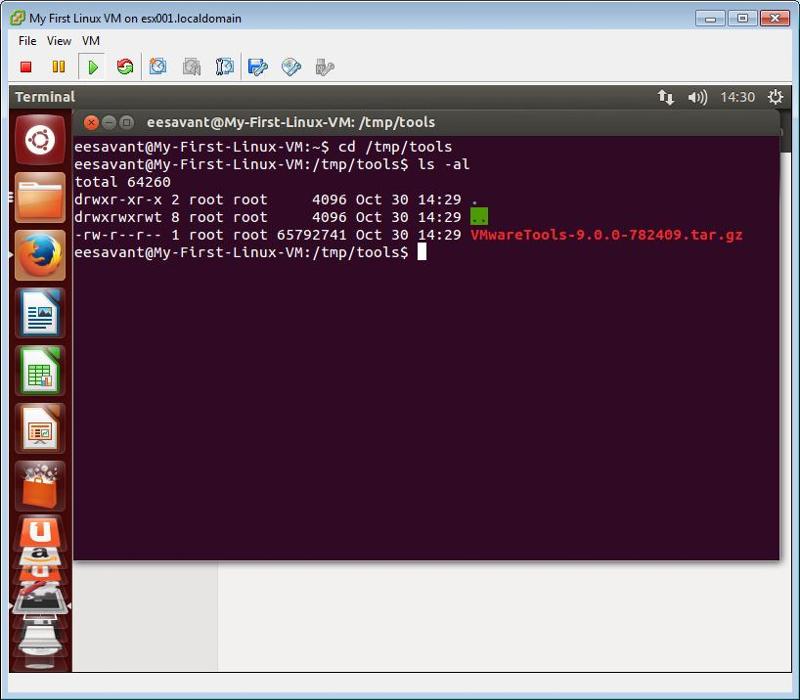 Extract the VMware Tools gziped tar ball file, by typing the following sudo tar zxvf VMwareTools-9.0.0-782409.t
Extract the VMware Tools gziped tar ball file, by typing the following sudo tar zxvf VMwareTools-9.0.0-782409.t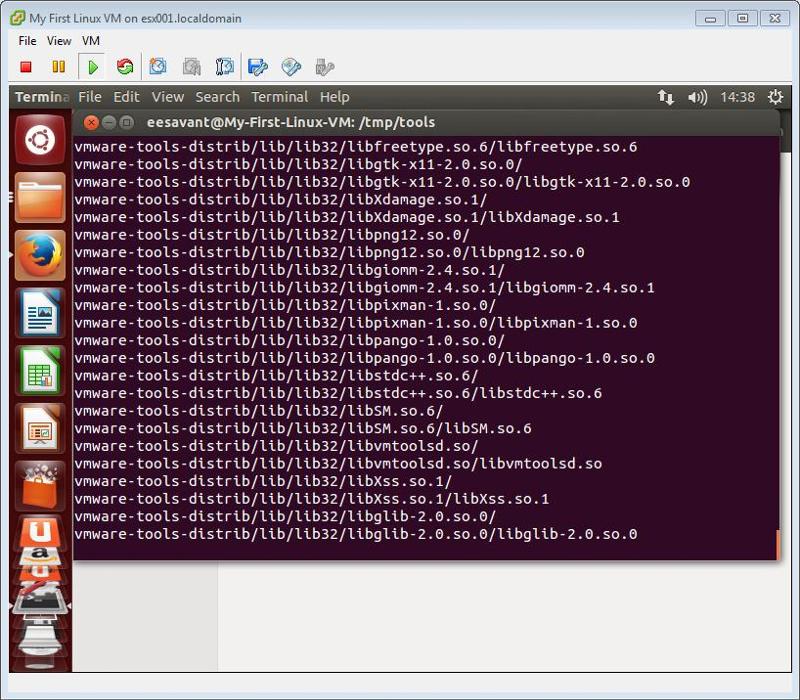 Check the current folder for the new folder called vmware-tools-distrib using the command ls -al. Change directory using the cd command, and type cd vmware-tools-distrib.
Check the current folder for the new folder called vmware-tools-distrib using the command ls -al. Change directory using the cd command, and type cd vmware-tools-distrib.
 gcc, make and the kernel headers of the running kernel are later required by the VMware Tools installation to compile the drivers for you Linux distribution, so install first, otherwise tools installation will fail. To check and install you have the binaries gcc and make type
gcc, make and the kernel headers of the running kernel are later required by the VMware Tools installation to compile the drivers for you Linux distribution, so install first, otherwise tools installation will fail. To check and install you have the binaries gcc and make type
sudo apt-get install gcc
sudo apt-get install make
sudo apt-get install linux-headers-generic
at the terminal window. Execute the VMware Tools installation script, by typing the command sudo ./vmware-install.pl
At the Creating a new VMware Tools installer database Installing VMware Tools prompt, just hit the enter key to accept the defaults to the following paths
/usr/bin
/etc
/etc/init.d
/usr/sbin/
/usr/lib/vmware-tools
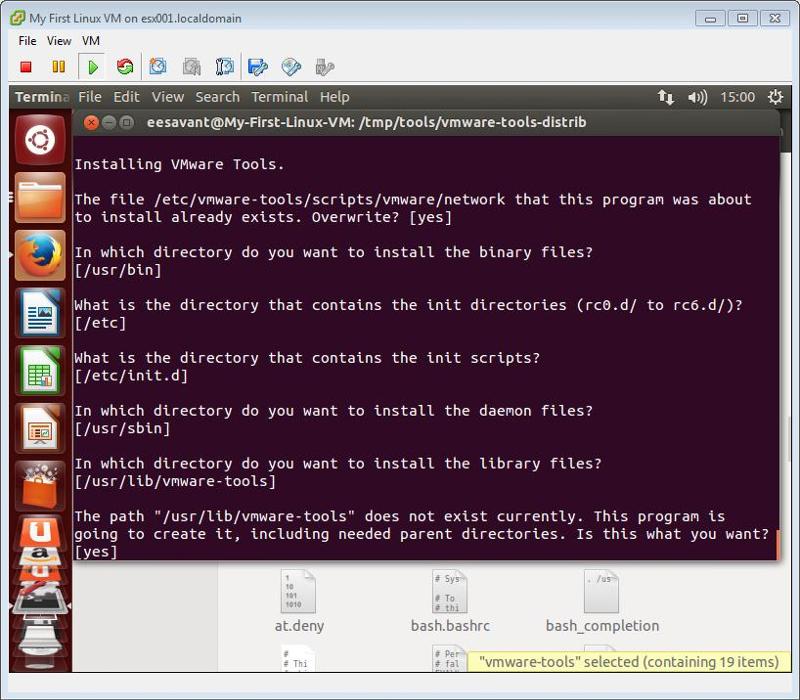 Answer yes to creating the folder /usr/lib/vmware-tools, this can take a few minutes to complete.
Answer yes to creating the folder /usr/lib/vmware-tools, this can take a few minutes to complete.
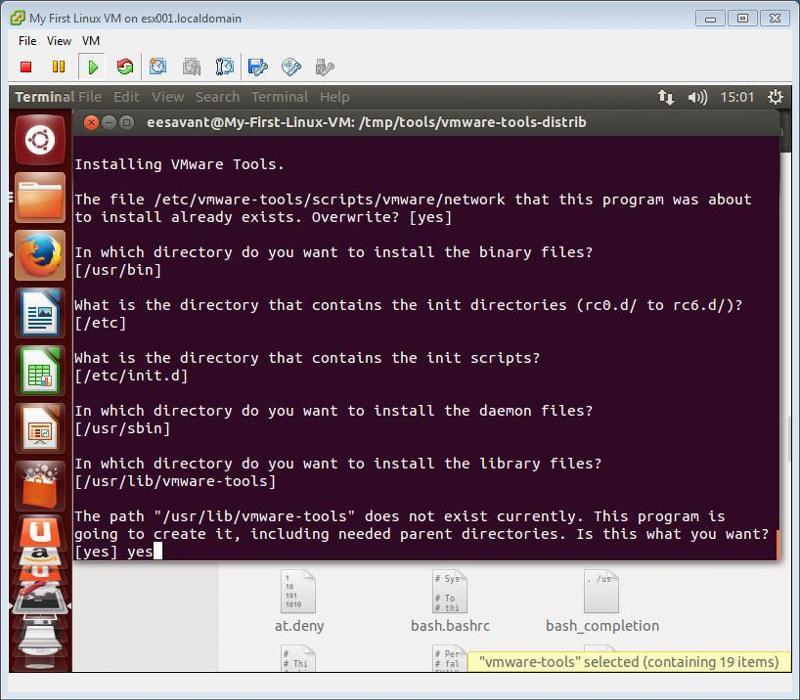 At the which directory do you want to install the documentation files, hit enter.
At the which directory do you want to install the documentation files, hit enter.
 Hit enter at the /usr/share/doc/vmware-tool
Hit enter at the /usr/share/doc/vmware-tool The VMware Tools installer, will report if the installation has been sccessful.
The VMware Tools installer, will report if the installation has been sccessful.
This will complete the installation of VMware Tools 9.0.0 build-782409 for Linux.
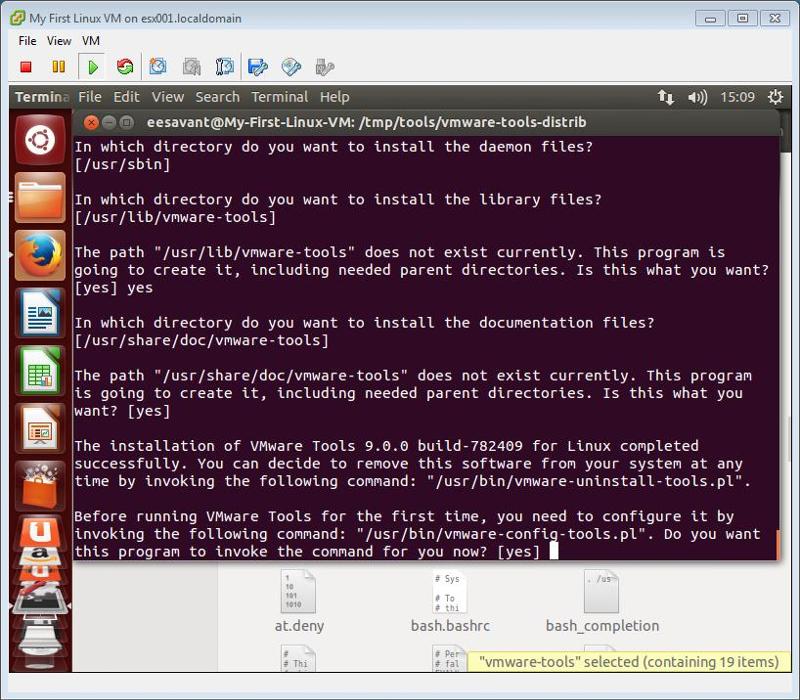 Before running VMware Tools for the first time, it needs to be configured. At the prompt to run the configuration program /usr/bin/vmware-config-too
Before running VMware Tools for the first time, it needs to be configured. At the prompt to run the configuration program /usr/bin/vmware-config-too The following screen will be displayed as VMware Tools initializes
The following screen will be displayed as VMware Tools initializes
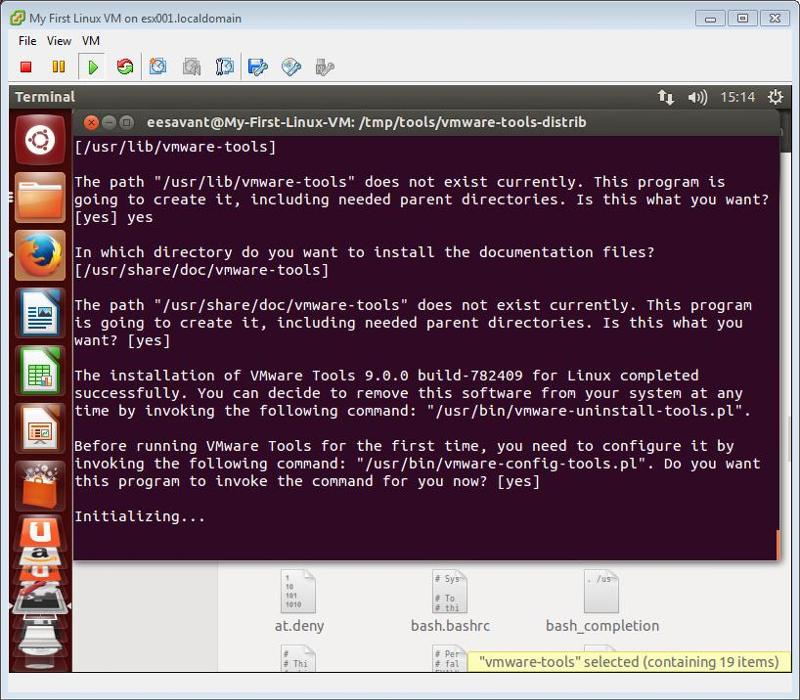 If you require the VMware FileSystem Sync Driver select - yes, this will ensure third party backup products, obtain a consistent backup.
If you require the VMware FileSystem Sync Driver select - yes, this will ensure third party backup products, obtain a consistent backup.
 Hit enter to accept the default path for gcc.
Hit enter to accept the default path for gcc.
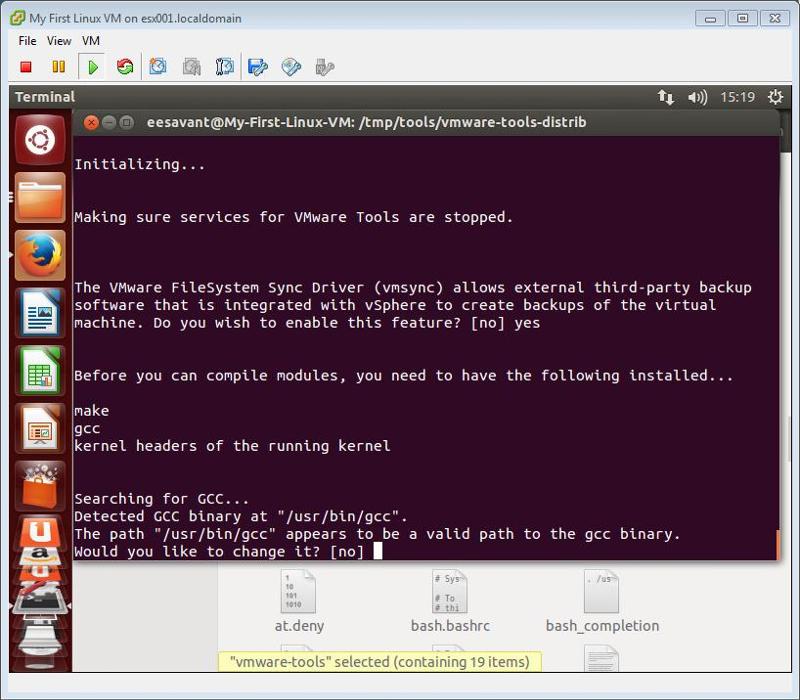 Hit enter to accept the default path for kernel headers.
Hit enter to accept the default path for kernel headers.
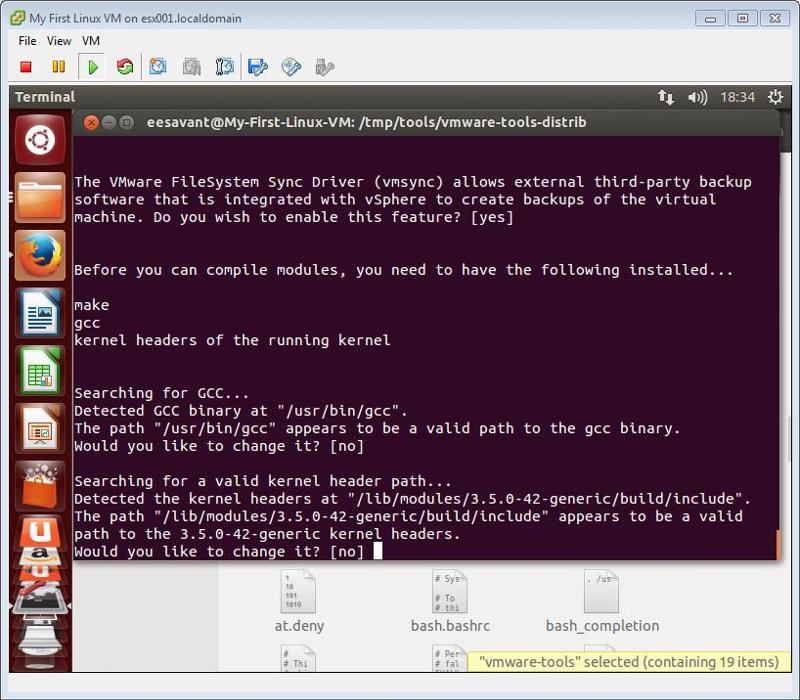 (if your kernel headers are missing, you will need to issue a sudo apt-get install linux-headers-generic command).
(if your kernel headers are missing, you will need to issue a sudo apt-get install linux-headers-generic command).
Hit enter to accept the default folder. The drivers will be compiled
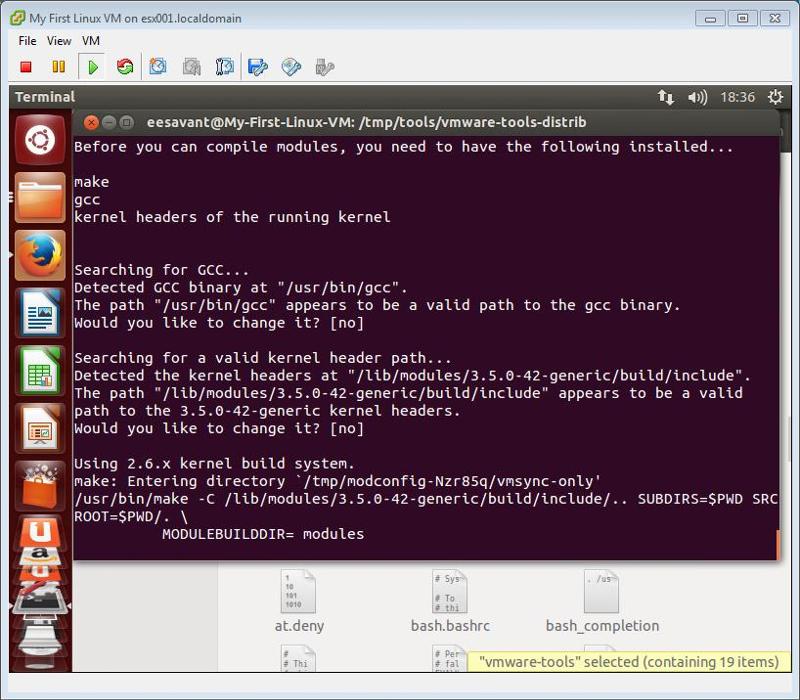
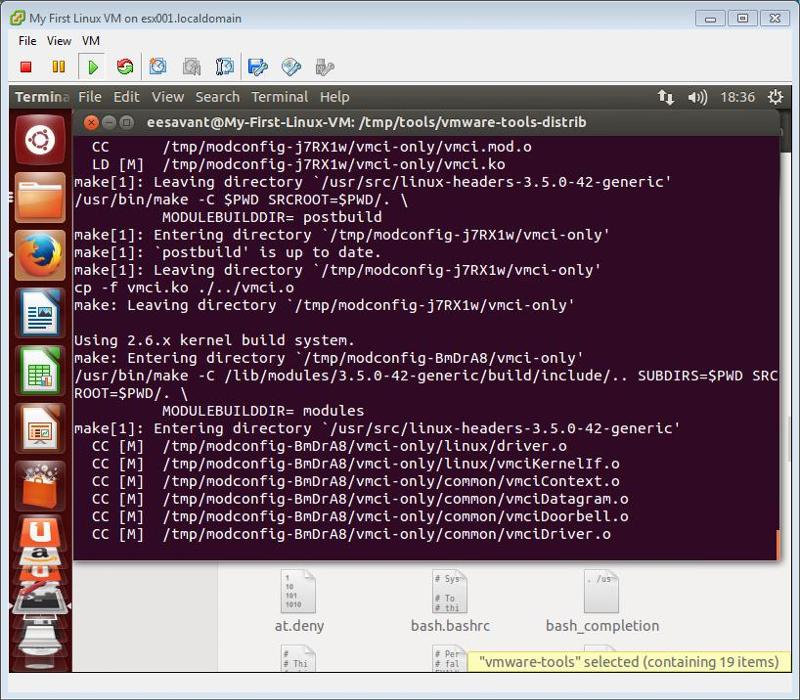
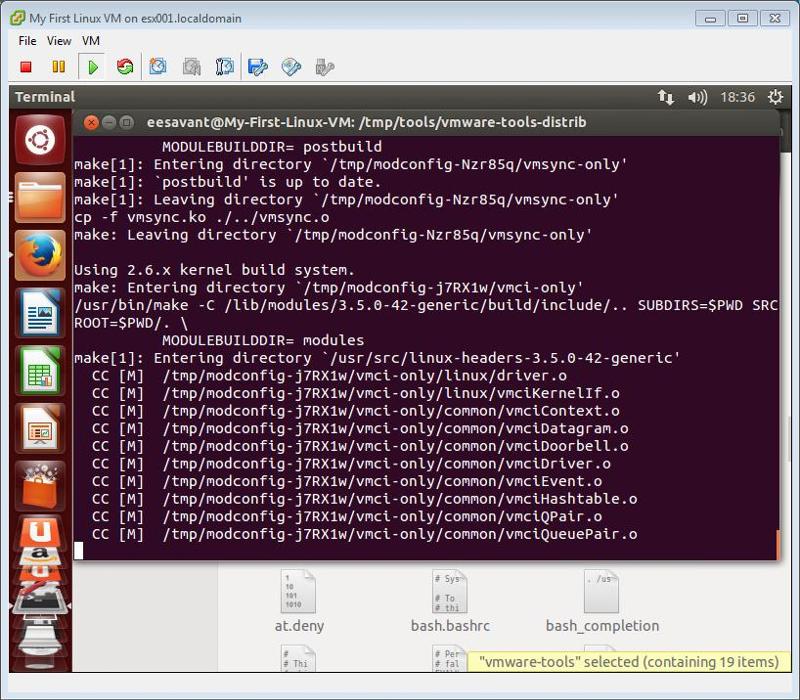
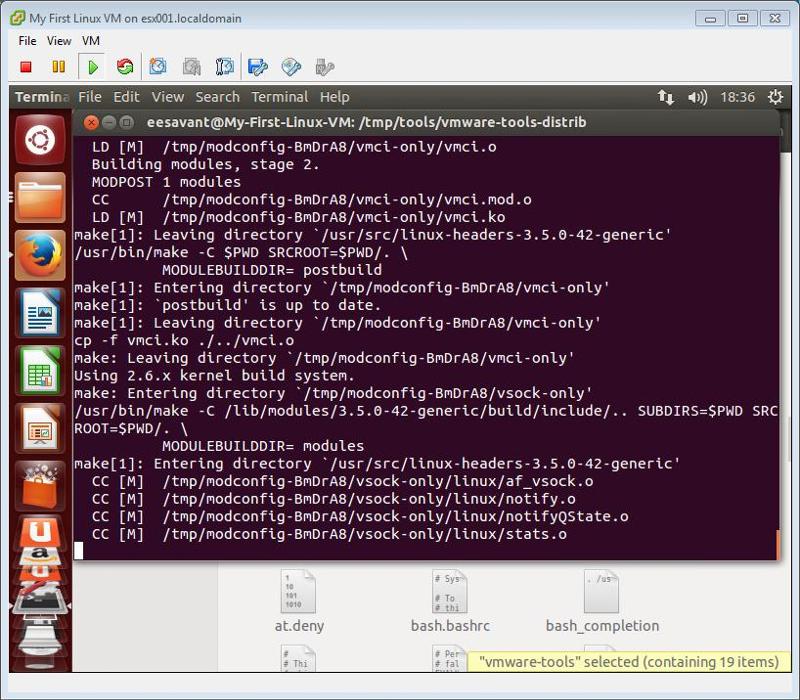
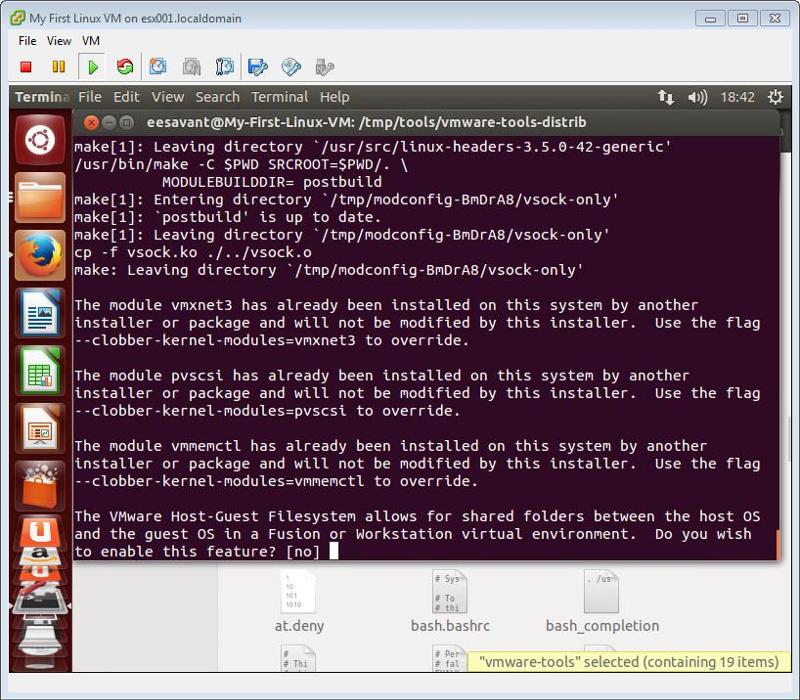 If you are using VMware Workstation or VMware Player, you may want to enable and install the VMware Host Guest Filesystem driver, which allows the exchange of files between host and virtual machine. This feature is not supported in VMware vSphere. In this tutorial, the Host is VMware vSphere, so we will not be installing the VMware Host Guest Filesystem driver, so select the default action - no.
If you are using VMware Workstation or VMware Player, you may want to enable and install the VMware Host Guest Filesystem driver, which allows the exchange of files between host and virtual machine. This feature is not supported in VMware vSphere. In this tutorial, the Host is VMware vSphere, so we will not be installing the VMware Host Guest Filesystem driver, so select the default action - no.
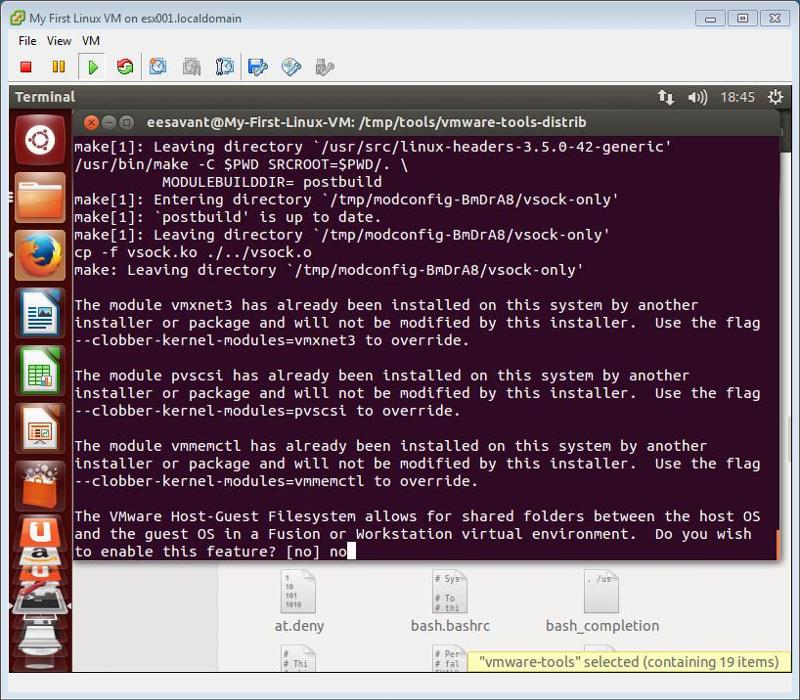 vmblock is a feature which allows cut and paste between Host computer and VMware Workstation or VMware Player virtual machine. This feature is not supported in VMware vSphere. In this tutorial, the Host is VMware vSphere, so we will not be installing the vmblock driver, so select the default action - no.
vmblock is a feature which allows cut and paste between Host computer and VMware Workstation or VMware Player virtual machine. This feature is not supported in VMware vSphere. In this tutorial, the Host is VMware vSphere, so we will not be installing the vmblock driver, so select the default action - no.
 As this is a production machine, we will not be installing any experimental VMware, automatic building kernels at machine boot. Accept the default no, but hitting Enter.
As this is a production machine, we will not be installing any experimental VMware, automatic building kernels at machine boot. Accept the default no, but hitting Enter.
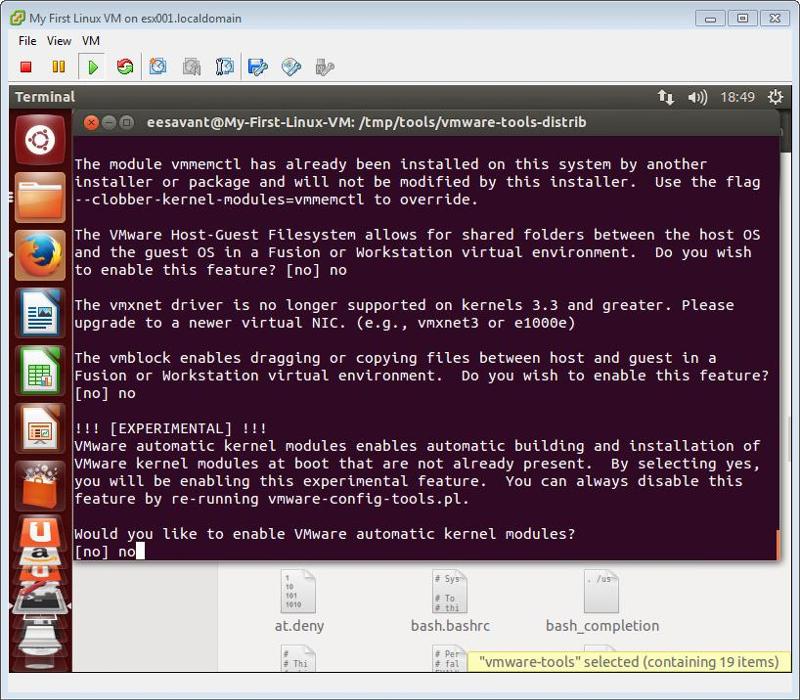 The configuration of VMware Tools 9.0.0 build-782409 for Linux has been completed successfully, when the following screen is displayed.
The configuration of VMware Tools 9.0.0 build-782409 for Linux has been completed successfully, when the following screen is displayed.
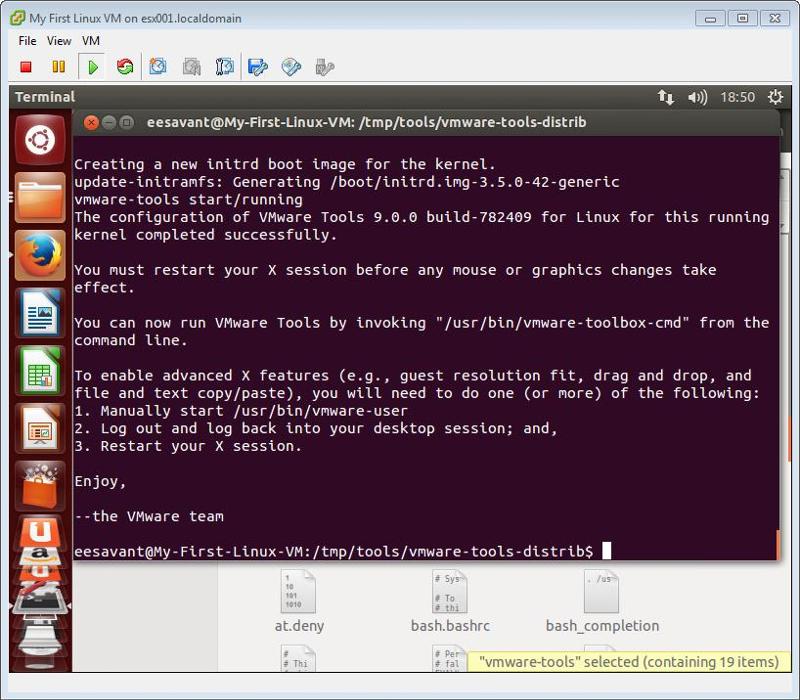 You must restart your X session before any mouse or graphics changes take effect.
You must restart your X session before any mouse or graphics changes take effect.
You can now run VMware Tools command box, by invoking sudo "/usr/bin/vmware-toolbox-c
Unlike in a Microsoft Windows operating system, and computer restart is not required to initialize VMware Tools.
If you now repeat Step 2 above Checking if VMware Tools is installed in the Virtual Machine

 An IP address is now displayed, which is the IP address of the virtual machine, VMware Tools Running Status - Running, and VMware Tools Version Status - Current
An IP address is now displayed, which is the IP address of the virtual machine, VMware Tools Running Status - Running, and VMware Tools Version Status - Current
Congratulations, you have successfully Installed VMware Tools for Linux on a VMware Linux virtual machine on a VMware vSphere Hypervisor 5.1 (ESXi 5.1) Host Server
**************************
Thank you for reading my article, please leave valuable feedback. If you liked my VMware article and would like to see more Articles from me, please click the Yes button near the: Was this article helpful? at the bottom of this article just below and to the right of this information. Thank You. Do not forget if you have a question about this article or another VMware, Virtualisation, Windows Server 2012 question, why not post a Question for me and the other Experts Exchange Experts in the VMware, Virtualisation, Windows 2008, Windows 2012 Zones. I look forward to hearing from you. - Andy :- twitter @einsteinagogo
**************************
Have a question about something in this article? You can receive help directly from the article author. Sign up for a free trial to get started.


Comments (0)